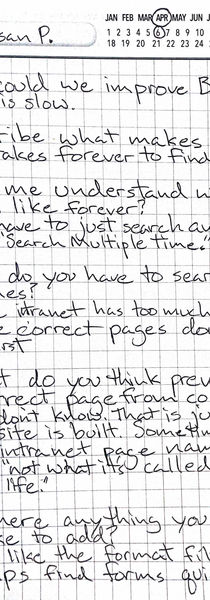
Inside My Process

Here to Serve
“Design Thinking on a sprint schedule” best describes my UX process for large organizations. The User-Centered Design activities and deliverables I use on projects change depending on the problem, company size, and culture.
Now that I have over a decade of practical knowledge, almost two decades, I see the peaks and valleys of a project. I know when to tell the team we are almost at the top or take a different trail to save some time. This experience allows me to travel lean, bringing just what I need for this project.
However, my leading principles remain the same.
Gain a deep understanding of the user's most pressing challenges.
Break down long-term objectives into short, actionable cycles.
Actively seek and embrace feedback at every juncture.
Implement insights derived from comprehensive testing.
Continuously acquire the knowledge necessary for progress.
Irrespective of the methodology chosen, I take pleasure in infusing technology with humanity. My drive stems from the chance to enhance both personal and professional lives.
"Continuous improvement is better than delayed perfection"
Mark Twain
Design Thinking
Empathize - Define - Ideate - Prototype - Test - Implement
I am solving real user problems using a consistent and outcome-driven methodology. Design Thinking is both a process and an ideology. The names of phases can vary but the basics are the same. The Design Thinking model I subscribe to for large companies is from Nielsen Norman Group (NNG). You can explore the forest to learn more about each phase!

Making UX Matter: The Promotional Advantage
I had to interrupt myself to emphasize a crucial aspect of UX design that often goes unnoticed – Promotion. I take it upon myself to share our work outside the team and educate the world about our process. In the realm of user experience, we frequently encounter challenges such as budget constraints, a lack of understanding, limited resources, and resistance to change. Yet, these challenges can be effectively mitigated through strategic promotion. By taking the time to inform the right individuals about the invaluable contributions of the UX team, we can bridge gaps in comprehension, secure essential resources, and foster a culture of collaboration.
Promoting the features we've meticulously crafted in UX design is not just a beneficial endeavor; it's a crucial component of delivering value to our users and ensuring that our efforts resonate with them. Here's why UX designers should actively engage in promoting their creations and how to effectively do so:
User-Centric Promotion: Users often struggle to recognize the value of new features unless we explicitly explain how these features address their pain points. By leveraging the insights gained from interviews and research, we can craft compelling narratives that highlight how these features directly benefit users. This user-centric approach makes the promotion not only informative but also relatable.
Alignment with Marketing Goals: While promotion may not be a traditional aspect of UX methodology, it seamlessly aligns with marketing objectives. It ensures that our design efforts are well-integrated into the overall marketing strategy. By speaking the language of our users, we create a unified and consistent message that reinforces the company's commitment to enhancing the user experience.
Incorporating User Language: One of the most effective strategies is to use the exact language spoken by users during interviews. This approach makes promotional content highly relatable, almost as if the users themselves are endorsing the features. When users recognize their own pain points and needs in our messaging, they're more likely to engage and explore the new features.
Internal Knowledge Sharing: To facilitate promotion, it's essential to create presentation materials that succinctly explain the features and their user-centric benefits. Sharing these materials internally via platforms like Slack or Teams ensures that everyone, from sales and marketing teams to product managers, is well-informed about the new features. This internal alignment helps everyone convey a consistent message to users.
Sales Enablement: Sales teams play a pivotal role in promoting products and features. Providing them with scripts that emphasize how the new features solve real user problems equips them with compelling narratives to share with potential customers. This not only boosts their confidence but also increases the chances of conversion.
Engaging with Customers: Beyond internal channels, consider direct engagement with customers through newsletters, blog posts, or social media. Showcase success stories or case studies that demonstrate how the new features have transformed users' experiences. Encourage user feedback and testimonials to build trust and credibility.
Feedback Loop: Promotion shouldn't be a one-way street. Use it as an opportunity to gather additional user feedback. Encourage users to share their thoughts and experiences with the new features. This feedback loop not only helps in further refinement but also keeps users engaged and invested in the product's evolution.
Incorporating promotion into our UX design process enriches the overall user experience. It ensures that our hard work in addressing pain points and enhancing usability doesn't go unnoticed. By actively promoting the value we bring to our users, we not only stay within the marketing budget but also contribute significantly to the product's success. It's a win-win strategy that fosters user satisfaction and brand loyalty.

Discovery
My Beloved BobNet
I discovered a lot about empathizing with my users while retiring BobNet, Robert Half's 10-year-old intranet. Its replacement would be a web-based, global workspace for 16,000 employees. The new SharePoint system would eventually:
decrease tech support tickets by 60%
boost mobile usage by 20,000 devices
raise adoption rates at our 345 worldwide locations
It surprised me when the discussion of a name change came up. Let me explain why, my first day at Robert Half was spent updating BobNet. It was dear to my heart. The name instantly described itself as an intranet for Robert Half employees. So changing the name never crossed my mind until we started conducting interviews.
While conducting user and stakeholder interviews, it became clear that calling the new intranet BobNet would negate all of our improvements. All the negatives would unfairly be projected on the new system. I listened to my users and remembered we were building it for them. In the end, our intranet got the fresh start it deserved and we named the intranet... Well, you can ask me in person.
To the right are screenshots of RH's external-facing site to show just how much things had changed in 10 years.

Begin with Empathy
Empathy is an essential part of the discovery process. Understanding the user helps us accelerate the decision process, putting us on the right path. As a UX designer, I prototype and validate ideas as efficiently as possible. We can understand another person’s expressions, needs, and motivations through the gathered research. Knowing the user's "why" allows us to work on the top challenge and provide true value to the customer. Customer Value = Business Value.
High Value & High Risk
How do you know which idea will bring the most customer value? Don't they all provide value? Test the High Value & High-Risk ideas first to minimize risk.
It is the risk we can to reduce through testing. Low-Risk features can often be implemented immediately since the risk is small. Treat this as a science experiment and turn your idea into a hypothesis:
We believe this [OUTCOME] will occur if [THESE USERS] successfully attain this [BENEFIT] from this [SOLUTION].
By using research and data analysis, we can find evidence that supports our hypothesis and move forward. If the evidence disproves the hypothesis then we can conclusively reject it. Let's start testing and see.

Discovery: Deliverables
I average about 70+ projects a year. I've provided user findings for Burger King with three 14 hour days and I have spent 2 years on Robert Half's intranet, often juggling more than one project. Below are some activities I conduct most often during phases that involve Empathy and Discovery.

Define & Develop
Define & Develop:
Deliverables
After organizing the team's observations and connecting common user pain points, I enjoy defining the path for my potential users, customers, and partners (B2B). I don't like to leave the user experience to chance. The following deliverables cover the Define, Ideate, Prototype, and Test phases of Design Thinking.

Free User Testing
When you release a product, Amazon and iTunes customers provide free user testing in the form of reviews. You can either plan to test your product or have your customers do it for you. Testing prototypes allows companies to prevent customers from seeing avoidable failures. There is no perfect app or way to satisfy every customer. We can, however, provide an amazing experience for our target customer.

Deliver Phase
Deliver: Deliverables
Say that five times fast!
It's time to launch your product and introduce your ideas to the market. This is why you started the project in the first place and it's the most important. This stage involves meeting deadlines, finalizing ideas, not settling for mediocrity, and exhaust every possible minute you have left until release.
Understand, Improve, Apply
As mentioned earlier, my extensive practical experience has provided me with the ability to discern the peaks and valleys within a project's landscape. Throughout my career, I've consistently amassed insights from diverse Design Thinking methodologies, and I'm dedicated to sharing these valuable discoveries with the broader community.
I'm enthusiastic about the opportunity to collaborate with you and look forward to our future journey together.




























